Women stands to gain a lot through yoga during her menopause. Women and their hormones have an interesting relationship. A subtle change to her hormones, in an undesirable way, is enough to disrupt her peaceful life. Menopause is one such stage in the life of a woman where hormones become uncontrollable. As she moves towards menopause, her ovaries stop functioning, forcing her reproductive hormones to withdraw themselves. And, this change brings with it an array of symptoms including depression and lack of sleep that just leaves her devastated.
Hot flushes, hypothyroidism, backache, brittle bones, joint pains, lack of sleep – menopause does sound annoying. But regular practice of yoga is one of many solutions to cope with this life change. Along with gifting her physical and mental peace, it keeps her bones safe. Her body calms down and she will be able to restore her balance to a great extent. Let’s take a look at some of the yoga poses that could help a woman during her menopause.
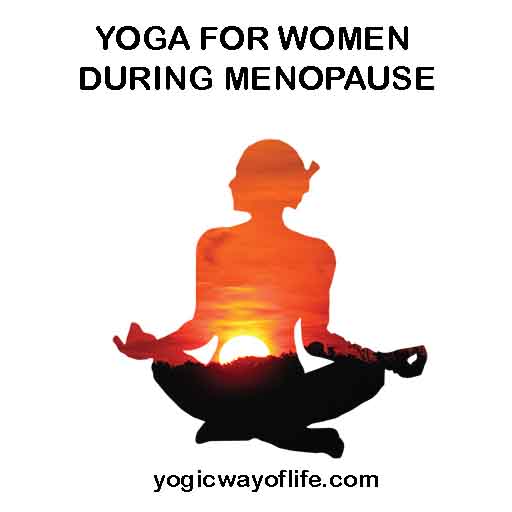
Yoga for Women during Menopause
The sequence comprises six yoga poses and one breathing technique.
-
Tadasana – Mountain Pose
Tadasana is one of the simplest of the asanas that does a good job in correcting your posture. Also, it is known to help you manage your hot flashes.
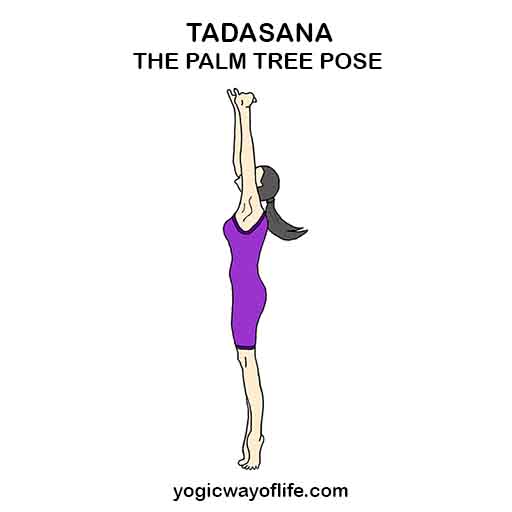
Stand with your feet slightly separated, spine straight, and palms resting on your outer thighs. Inhale and swing your arms over your head and stretch your torso. Simultaneously, press your feet into the floor. Once you are stable, if possible, lift your heels and balance on the soles of your feet. Gaze at a point ahead and balance for five deep breaths.
-
Padahastasana / Uttanasana – Standing Forward Fold
A mild inversion pose, this is very commonly advised to combat osteoporosis as well as menopause. A gentle hamstring and hip stretching exercise, it eases stress. It is also a good posture to alleviate digestive discomforts experienced during this phase of life.
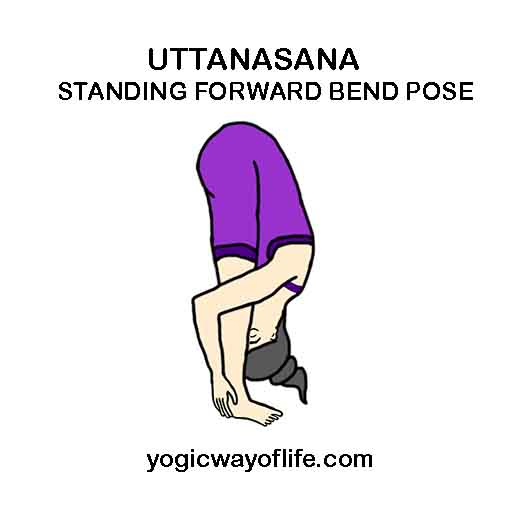
From Tadasana, exhale and come back to the initial position. Inhale and swing your hands over your head. As you exhale, bend forward from the hips and place your palms on either side of your feet. Keep your knees slightly bent. Allow the abdomen to rest on your thighs and relax your shoulders. If possible, rest your forehead close to the shin. Hold the posture for five deep breaths.
Tips: If you are not able to reach the floor, rest your palms on your shin. Bend your elbows sideways and bend forward with each exhalation.
-
Adho Mukha Svanasana – Downward Facing Dog Pose
With its innumerable benefits, it is one posture you could do wherever and whenever you wish for a whole body stretching experience. However, if balancing on all your fours with hips pointing to the ceiling seems challenging, take the help of a table or wall. Along with combating your menopausal distress, it is also effective in preventing the onset of osteoporosis.
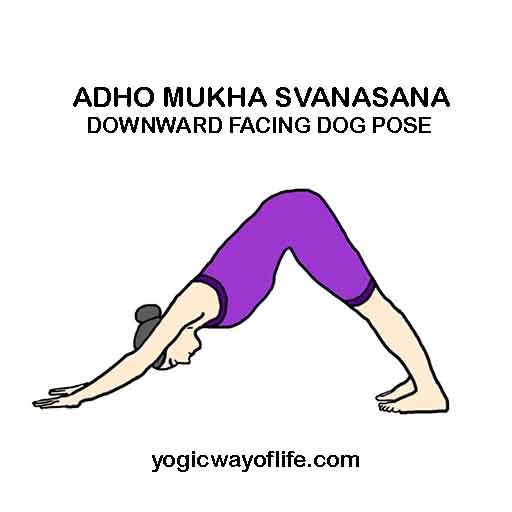
From Hastapadasana, walk your legs back. Planting the feet firmly into the floor, push your hips up towards the sky. Adjust your shoulders and elbows so that the wrists, elbows, and shoulders are in the same line. Do not lock your elbows; keep them slightly bent. It’s okay even if your heels are slightly away from the floor. Push your body away from the floor and keep lifting your hips to the ceiling. Hold the posture for five deep breaths.
-
Marjariasana – Cat Stretch
Calm your sore and aching back muscles while bidding adieu to stress with this lovely flowing breath. Also, it works on soothing your troubled tummy and soothes your uterus and ovaries. Just ensure that you are keeping your arms straight throughout the practice.
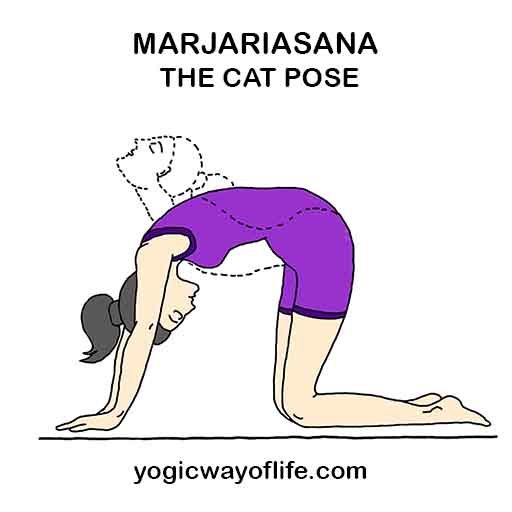
From Adho Mukha Svanasana, drop your knees down. Separate your knees and feet as wide as your hips. Adjust your arms so that they are shoulder-width apart. Spread your fingers wide. Move your torso slightly forward to stack your shoulders over your wrists. Extend your feet so that toes point away from your body.
Inhale, arch your back, and raise your head. Allow the abdomen to expand completely. Fill your lungs as much as possible. As you exhale, tuck your chin to the chest, round your back, empty your abdomen, and pull the navel close to the spine. Squeeze your buttocks and gaze down.
Repeat the movement 7 to 10 times, syncing your movements with the breath.
-
Setubhandasana / Kandharasana – The Bridge Pose
The bridge pose is an excellent way to relieve stress and manage the symptoms of menopause. Practicing the bridge pose stretches and strengthens the back, reduces fatigue and insomnia, and eases anxiety and headaches.
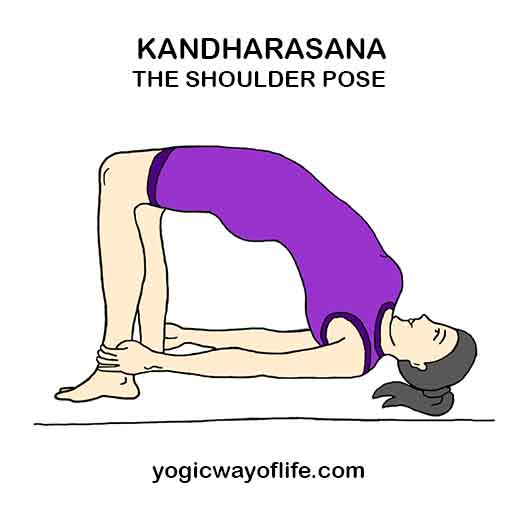
From Marjariasana, sit on the heels and extend your legs out. Gently lie down on your back. Bend your knees and separate your feet as wide as your hips. Allow the feet to come as close to your hips as possible. Let your arms rest along your body, palms pressing into the floor.
On an inhale, press the palms and feet into the floor and lift your hips away from the floor. Engage your core muscles, squeeze your buttocks, and roll your thighs inward. Take a short exhalation and on the next inhalation, lift your hips and torso higher so that chest is closer to your chin.
Hold the pose, continuing deep abdominal breathing, for seven breaths.
-
Supta Baddha Konasana – Reclining Butterfly Pose
Reclining in this posture is fabulously relaxing. It releases the tension from your hips and groins. It massages your back and calms you stress.
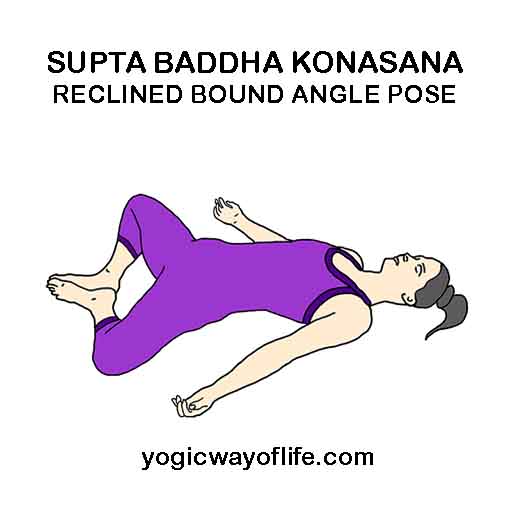
Exhale in Setu Bhandasana and gently release your lower back and hips to the floor. Bend your knees out and join the soles of your feet. Rest your arms over your head, forearms perpendicular to your shoulders. Close your eyes and just relax.
Focus on abdominal breathing. Allow your abdomen to expand as you inhale. Let your navel fall close to your spine with exhalation. Take slow deep breaths and remain in the posture for about 5 minutes.
-
Anulom Vilom Pranayama – Alternate Nostril Breathing
Mindful breathing is the best way to calm a stressful body and mind. And, Anulom Vilom is a great cleansing, rejuvenating breath that alleviates stress and helps you to manage menopausal symptoms in a better way.
From Supta Baddha Konasana, stretch your legs. Bend your knees and turn to the right. Place your left palm on the floor. Press the palm and sit in any comfortable seated posture. Keep your spine erect. Let your palms rest on your knees. Close your eyes. Take seven deep breaths to prepare your body and mind for the practice.
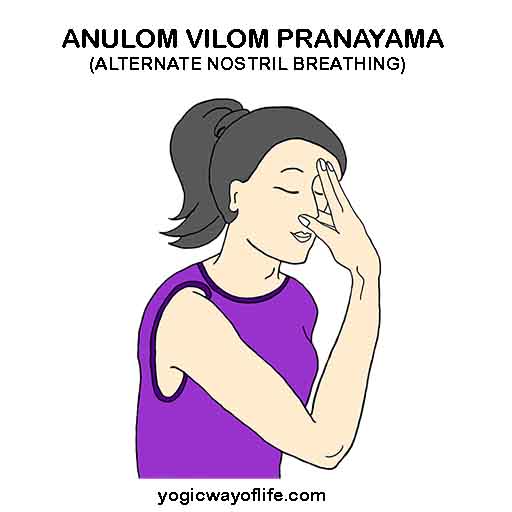
Join the tips of the thumb and index finger of your left palm. Use your right palm to close the nostrils. The right thumb closes the right nostril and the ring finger the left nostril. Place the tips of your middle and index fingers in between your eyebrows, Stretch the little finger to the ceiling.
Open the left nostril and exhale completely. Inhale through the left nostril for a count of 4. Close the left nostril, open the right, and exhale for a count of 4. Inhale through the right for a count of 4, close the right, open the left, and exhale through the left. The exhalation completes one round of Anulom Vilom Pranayama. Practice 10 such rounds.
Tips: Once you are comfortable with this practice, change the ratio of inhalation and exhalation into the ratio 1:2. You could also try holding the breath after each inhalation for the same count as inhalation.
Inhale through your left nostril for a count of 4. Close your left nostril and hold the breath for a count of 4. Open your right nostril and exhale for a count of 8. Repeat breathing in the same way by inhaling through the right for 4, retaining for a count of 4, and exhaling for a count of 8.
Once you complete the breathing practice, release the nostrils, and rest your palms on your knees. Bend your little and ring fingers and let their tips come into contact with the tips of the thumbs. Use the same Mudra in both hands. Close your eyes and relax for 10 minutes. Focus on your breath. Just observe it… Allow the feelings, thoughts, and emotions to arise. Do not attempt to change any of those. Just observe those and let go.
When you are ready, rub your palms and generate warmth. Place the palms on your eyes. Blink your eyes and look at your palms.
You are now ready to recapture your world!
Along with a regular, calming yoga routine, incorporate a healthy, balanced diet. The life will be yours again!
